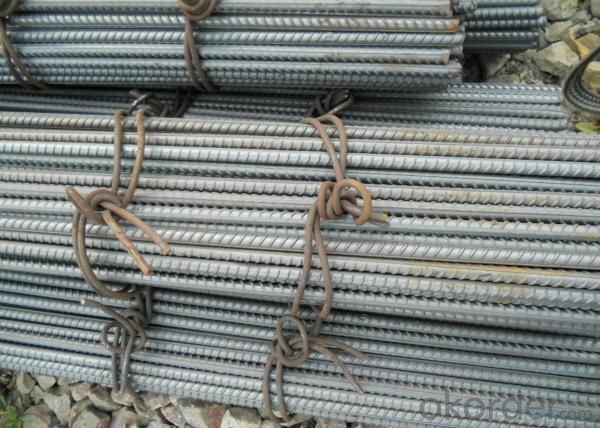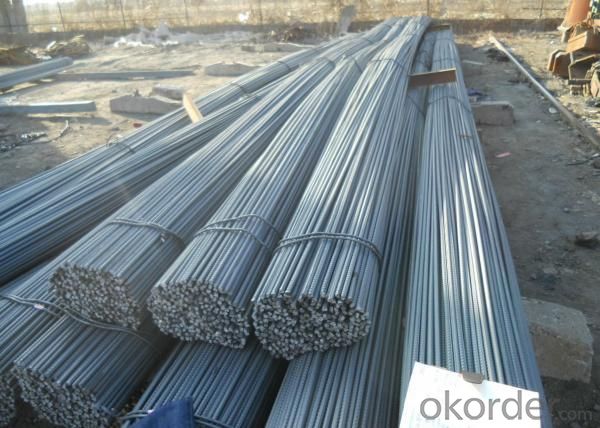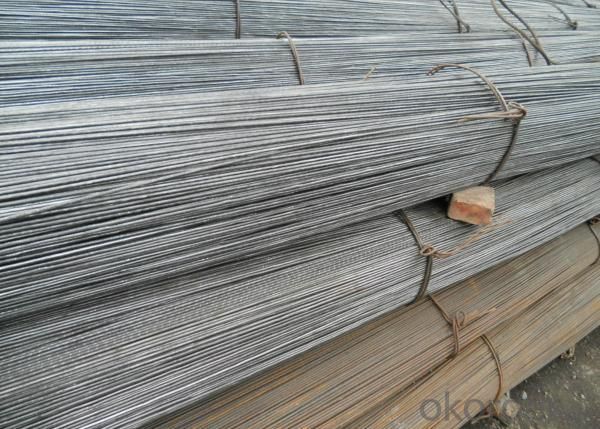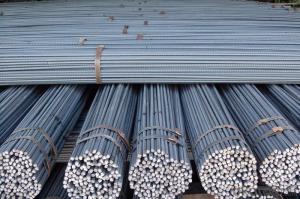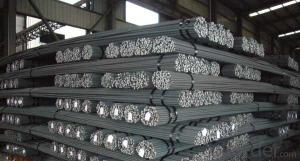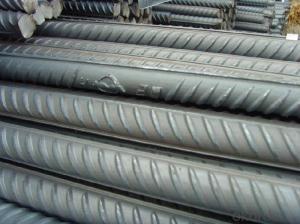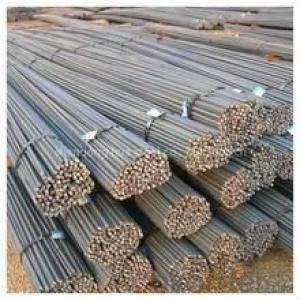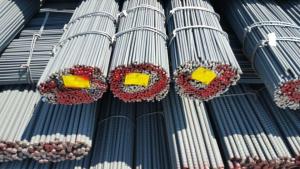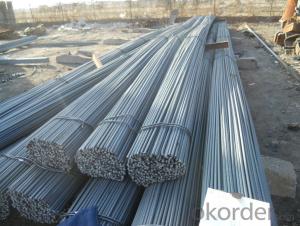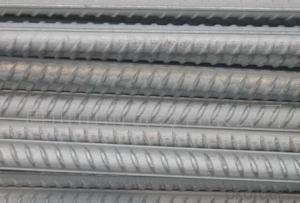Deformed Steel Rebars
- Loading Port:
- China Main Port
- Payment Terms:
- TT or LC
- Min Order Qty:
- 25MT m.t.
- Supply Capability:
- 800000TONS/YEAR m.t./month
OKorder Service Pledge
OKorder Financial Service
You Might Also Like
Specifications of Deformed Steel Rebars:
Standard | GB UK USA | HRB335 HRB400 HRB500 G460B, B500A, B500B,B500C GR40, GR60 | |
Diameter | 6mm,8mm,10mm,12mm,14mm,16mm,18mm,20mm, 22mm,25mm,28mm,32mm,36mm,40mm,50mm | ||
Length | 6M, 9M,12M or as required | ||
Payment terms | TT payment in advance or Irrevocable LC at sight. | ||
Each bundle weight | 2-3MT, or as required | ||
Trade terms | FOB, CFR, CIF | ||
Delivery Detail | within 45 days after received advanced payment or LC. | ||
Type | Hot rolled steel rebar | ||
Brand name | DRAGON | ||
Chemical Composition: (Please kindly find our chemistry of our material based on BS4449 as below for your information)
BS4449 500B | Chemical Composition | ||||
C | Mn | Si | S | P | |
0.24 | 0.45 | 0.16 | 0.05 | 0.31 | |
Physical capability | |||||
Yield Strength(N/cm²) | Tensile Strength(N/cm²) | Elongation (%) | |||
650 | ≥500 | 19 | |||
Deformed Steel Rebars in stock
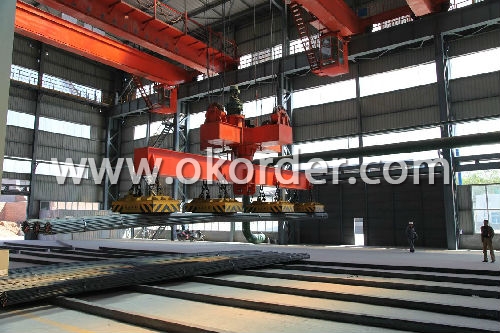
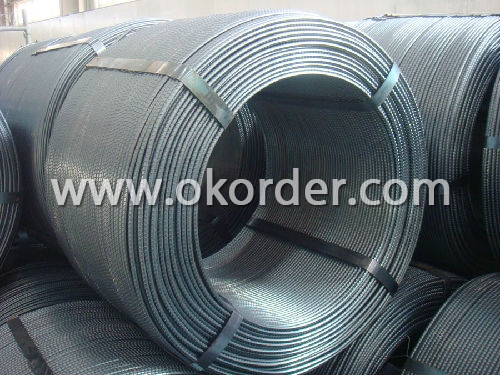
Usage and Applications of Deformed Steel Rebars:
Deformed bar is widely used in buildings, bridges, roads and other engineering construction. Big to highways, railways, bridges, culverts, tunnels, public facilities such as flood control, dam, small to housing construction, beam, column, wall and the foundation of the plate, deformed bar is an integral structure material. With the development of world economy and the vigorous development of infrastructure construction, real estate, the demand for deformed bar will be larger and larger..
Packaging & Delivery of Deformed Steel Rebars:
Packaging Detail: products are packed in bundle and then shipped by container or bulk vessel, deformed bar is usually naked strapping delivery, when storing, please pay attention to moisture proof. The performance of rust will produce adverse effect.
Price:Keep lower operating costs so as to offer competitive price for our clients
Label:to be specified by customer, generally, each bundle has 1-2 labels
Invoice:Actual or Theoretical Weight Basis as buyer’s request.
Note:
1. Our products are produced according to national standard (GB), if not, supply according to national standards (GB) or agreement as customer required.
2. Other Grade and Standard Deformed Steel Bar we can supply:
Grade: GR40/GR60, G460B/B500A/B500B/B500C,BST500S
Standard: ASTM, BS, DIN
The Minimum Order Quantity of these products is high, and need to be confirmed.
3. We can not only supply Deformed Steel Bar; if you need anything about building materials, please contact us for further information.
4. Please send us your detail specifications when inquire. We will reply to you as soon as possible. We sincerely hope we can establish a long stable business relationship.
- Q: What are the guidelines for the proper spacing of steel rebars in slabs-on-grade?
- To ensure the structural integrity and longevity of the concrete slab, it is crucial to follow guidelines for spacing steel rebars in slabs-on-grade. Here are the general guidelines to be followed: 1. Concrete cover: The first consideration is the distance between the rebar surface and the concrete edge, known as the concrete cover. Local building codes or engineering standards typically specify the minimum cover requirements, which must be strictly adhered to. This cover protects the rebar from corrosion and provides fire resistance. 2. Rebar spacing: The spacing between rebars depends on the load requirements and slab dimensions. A closer spacing results in a stronger slab. However, it is necessary to maintain proper spacing to allow free flow of concrete around the rebar during pouring and ensure proper consolidation. Generally, the spacing should not exceed three times the slab thickness or 18 inches, whichever is smaller. 3. Rebar size and diameter: The selection of rebar size and diameter depends on the load requirements and design specifications. Larger loads require larger diameter rebars with increased spacing. Common rebar sizes for slabs-on-grade range from #3 (3/8 inch diameter) to #8 (1 inch diameter). 4. Rebar placement: Proper placement of rebars within the slab is critical. The rebars should be positioned at the center of the slab's thickness to ensure even load distribution. Moreover, they should be securely tied or supported to prevent displacement during concrete placement and consolidation. 5. Joint reinforcement: Construction joints are often included in slabs-on-grade to accommodate expansion and contraction. Proper reinforcement of these joints is essential for maintaining structural integrity. Joint reinforcement, such as dowel bars or tie bars, should be placed perpendicular to the joint and adequately anchored on both sides. It is important to note that these guidelines provide a general overview, and specific project requirements may vary. Consulting a structural engineer or following local building codes and industry standards is essential to ensure compliance and optimize the design of steel rebars in slabs-on-grade.
- Q: What is the purpose of using steel rebars in concrete structures?
- The purpose of using steel rebars in concrete structures is to provide reinforcement and enhance the strength and durability of the concrete. The rebars help to counteract the tensile forces that concrete is weak against, preventing cracks and structural failure. By adding steel rebars, the overall load-bearing capacity of the concrete structure is significantly increased, ensuring its stability and longevity.
- Q: What are the environmental benefits of using steel rebars?
- Several environmental benefits are associated with the use of steel rebars in construction projects. Firstly, steel rebars can be reused or repurposed due to the high recyclability of steel. This reduces the need for new steel production and decreases the amount of waste sent to landfills. Furthermore, steel rebars have a longer lifespan compared to other construction materials like wood or concrete. This durability reduces the frequency of replacements and repairs, thereby decreasing the environmental impact related to the production and transportation of new materials. In addition, steel rebars provide superior strength and stability, leading to more resilient structures. This helps minimize the risk of structural failures or collapses, which can result in severe environmental consequences. By incorporating steel rebars, buildings and infrastructure gain enhanced overall safety and longevity, reducing the need for extensive future reconstruction or demolition. Moreover, steel rebars are resistant to corrosion, requiring less maintenance and upkeep over time. This reduces the use of chemicals and resources typically necessary for maintenance purposes, resulting in a lower environmental impact. Finally, steel rebars can be manufactured with a high percentage of recycled content, reducing the demand for new steel extraction and mitigating associated environmental impacts like deforestation and habitat destruction. Overall, the utilization of steel rebars in construction projects brings several environmental benefits, including the reduction of waste generation, increased durability, enhanced structural safety, lower maintenance requirements, and decreased reliance on new steel production.
- Q: Can steel rebars be used in structures with high resistance to vibration?
- Yes, steel rebars can be used in structures with high resistance to vibration. Steel rebars have excellent strength and durability properties, making them suitable for reinforcing structures that are subjected to vibrations, such as bridges, high-rise buildings, and industrial facilities. The use of steel rebars helps enhance the structural integrity and stability of these structures, ensuring their ability to withstand and dissipate vibrations effectively.
- Q: What are the different types of steel rebars used in retaining wall constructions?
- There are several types of steel rebars commonly used in retaining wall constructions, including plain carbon steel rebars, epoxy-coated rebars, galvanized rebars, and stainless steel rebars. Each type has its own unique properties and benefits, such as increased corrosion resistance or enhanced durability, allowing for the selection of the most suitable option based on the specific requirements of the retaining wall project.
- Q: Can the bars of steel bars be replaced by round steel bars?
- Important stress parts should not be adopted. Reinforced surface made of thread, herringbone bond force is increased to crescent, steel and concrete, reinforced some parts if it is ends with a ribbed design can not bend, it is possible to design directly paste up, it is best to ask the design unit.
- Q: Are there any disadvantages to using steel rebars?
- Yes, there are some disadvantages to using steel rebars. Firstly, steel rebars can corrode over time, especially in environments with high moisture or exposure to chemicals, which can reduce their strength and durability. Additionally, steel rebars are susceptible to thermal expansion and contraction, leading to cracking in concrete structures. Moreover, steel rebars are heavy and can be challenging to handle and transport, making construction processes more labor-intensive.
- Q: How do steel rebars contribute to the overall structural performance of a building?
- Steel rebars play a crucial role in enhancing the overall structural performance of a building. These reinforced steel bars are primarily used in concrete construction and provide strength and stability to the structure. Firstly, rebars reinforce the concrete by increasing its tensile strength. Concrete is highly resistant to compression forces, but it is weak when it comes to tension. By adding steel rebars, which have excellent tensile strength, to the concrete, the resulting composite material becomes much stronger and more resistant to bending or cracking under pressure. Moreover, rebars improve the durability and longevity of the building. Concrete structures are subjected to various forces such as wind, earthquakes, and heavy loads. Steel rebars act as a reinforcement network, distributing these forces throughout the concrete and preventing localized damage. This reinforcement helps to minimize the risk of structural failure, ensuring the building can withstand the test of time and environmental conditions. In addition, rebars contribute to the overall stability of the structure. By reinforcing concrete columns, beams, and slabs, rebars enhance their load-bearing capacity. This enables the building to support heavier loads without excessive deflection or collapse. The increased stability provided by the rebars also allows for more flexible and creative architectural designs, as they provide the necessary structural support for complex and unique building shapes. Furthermore, steel rebars are essential in seismic zones where earthquakes are common. The ductility and flexibility of steel allow it to absorb and dissipate the energy generated during an earthquake. This prevents the building from undergoing severe damage and helps it to retain its structural integrity, minimizing the risk to occupants. Overall, steel rebars significantly contribute to the overall structural performance of a building by enhancing its strength, durability, stability, and resistance to various forces. Their use ensures that the structure remains safe, long-lasting, and capable of withstanding the demands placed upon it, making them an indispensable component in modern construction.
- Q: How are steel rebars measured and priced in the market?
- Steel rebars are typically measured and priced in the market based on their diameter, length, and weight. The diameter of the rebars is measured in millimeters, and the length is usually standardized at either 6 or 12 meters. The weight of the rebars is determined by calculating the volume of steel used, and it is usually expressed in kilograms or metric tons. Pricing of steel rebars in the market is influenced by various factors such as the current demand and supply, production costs, and market competition.
- Q: How are steel rebars measured and priced?
- Steel rebars are typically measured and priced based on their length, thickness, and weight. The length is measured in feet or meters, and the thickness is measured in inches or millimeters. The weight is usually given in pounds or kilograms. The pricing of steel rebars depends on current market conditions, including factors such as supply and demand, raw material costs, and manufacturing expenses. Additionally, any additional processing or customization requested by the customer may also impact the final price.
1. Manufacturer Overview
| Location | Hebei, China |
| Year Established | 2009 |
| Annual Output Value | Above US$ 500 Million |
| Main Markets | Southeast Asia; East Asia; Middle east |
| Company Certifications | ISO 9001:2008 |
2. Manufacturer Certificates
| a) Certification Name | |
| Range | |
| Reference | |
| Validity Period |
3. Manufacturer Capability
| a) Trade Capacity | |
| Nearest Port | Tianjin; |
| Export Percentage | 40%-60% |
| No.of Employees in Trade Department | 21-60 People |
| Language Spoken: | English; Chinese |
| b) Factory Information | |
| Factory Size: | Above 850,000 square meters |
| No. of Production Lines | Above 5 |
| Contract Manufacturing | OEM service offered |
| Product Price Range | high; average |
Send your message to us
Deformed Steel Rebars
- Loading Port:
- China Main Port
- Payment Terms:
- TT or LC
- Min Order Qty:
- 25MT m.t.
- Supply Capability:
- 800000TONS/YEAR m.t./month
OKorder Service Pledge
OKorder Financial Service
Similar products
Hot products
Hot Searches
Related keywords



